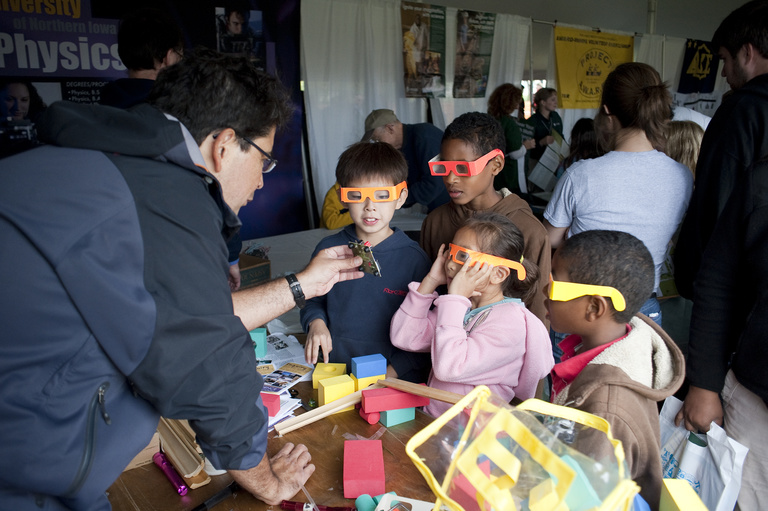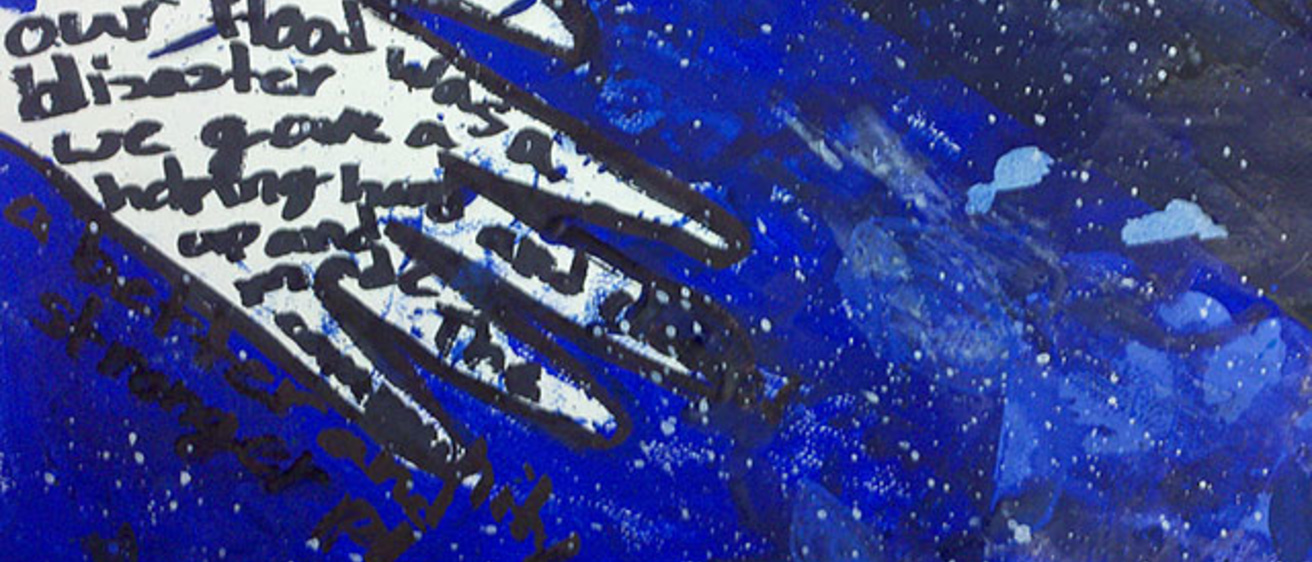May 31: The University of Iowa and communities across Iowa are confronting another flood season. Find the latest information about campus preparations and more at now.uiowa.edu/keywords/flood-updates-2013.
Chuck Swanson and the staff at Hancher had a germ of an idea. The performing arts organization wanted to work with the University of Iowa College of Engineering. Little did they know that they would spread a contagion across the entire state and even down the Mississippi River to New Orleans.
Happily, everyone that they’ve come in contact with has been infected only with the spirit of collaboration and cooperation. The result is a wide-ranging project called “ Living With Floods,” an effort to commemorate and learn from the experience of Iowa floods in 2008 and 2011. The effort culminates this June with free outdoor concerts by the New Orleans-based Preservation Hall Jazz Band in seven Iowa cities that were affected by floods.
To read a related story, see Music to commemorate some challenging times at now.uiowa.edu/2013/05/music-commemorate-some-challenging-times.
Collaboration has been a way of life for the Hancher staff since the Flood of 2008 forced them out of their building and into a variety of venues in Iowa City and around the state. But “Living With Floods” takes it to a new level. Consider:
- Seven University of Iowa departments are partnering on the project with support from the UI College of Engineering, Hancher and Back to the River.
- Additional support is being provided by the Iowa Arts Council and the National Endowment for the Arts
- Seven Iowa cities are participating—Des Moines, Council Bluffs, Muscatine, Cedar Rapids, Davenport, Dubuque, and Iowa City—hosting the concerts as well as forums for improving future flood responses
- Twenty-seven teachers from seven school districts participated in a Flood Institute organized by the UI College of Education and held at the UI
- Hundreds of elementary and middle school students in those schools are working on Living With Floods projects this spring and beyond
“Two years ago, I said to our staff, ‘We’ve never partnered with the College of Engineering. We’ve got to do something with them,’” Swanson says. “We also knew we wanted to do something statewide to commemorate the floods of 2008 and 2011, and that we wanted to do something with Iowa schools.”
The College of Engineering was surprised but eager to work with Hancher, says Associate Dean and Professor Greg Carmichael. Coincidentally, administrators there had been working on a response to the university strategic plan that called for engagement with the arts, so the two groups began meeting to work on a plan of action.
“Chuck’s group came up with the great idea of getting the Preservation Hall Jazz Band for concerts,” Carmichael says. “The symmetry of that was really nice, considering all that New Orleans went through during Hurricane Katrina.”
Hashing out a curricular component wasn’t easy. The group brainstormed for months but was having trouble making progress, says Carmen Langel, director of development and communication with the engineering school’s Flood Center. “How do we connect the science with the arts and music?” was the question that group kept returning to until a bit of serendipity came to the rescue: Swanson talked about the project with Yukiko Hill, a local elementary school teacher, who urged him to get in touch with two UI women who had organized a highly successful Science, Technology, Engineering, and Math (STEM) festival.

Those two were Gina Schatteman, emeritus professor of health and human physiology, and Beth Hochstedler, director of education, training and outreach at the State Hygienic Lab at the UI. In the fall of 2011, their STEM festival drew 2,000 attendants from around the state to the Lab. They were helping organize a series of regional STEM festivals when Hancher’s Swanson learned about that effort and contacted them.
“Gina and Beth became part of the committee and all of a sudden, a lot of work got done,” Swanson recalls.
Langel agrees: “The STEM festivals were a logical connection, and that led us to make the connection with the College of Education and the teachers. That’s when it all started to make sense.”
By reaching out to the College of Education, the group tapped the knowledge and wisdom of experts in curriculum development, including Greg Hamot, a professor of secondary social studies education. Hamot and others from the College of Education helped hatch the idea to hold a Flood Institute for elementary and middle school teachers.
“We wanted to develop a project that was interdisciplinary and would help create a product to represent the communities’ resilience to flooding,” Hamot says. Just as important, the group wanted to include a range of teachers: science, art, music, language arts, and social studies. And they wanted to make it easy for teachers to incorporate the project into their existing classes.
Art teacher Barb McCuskey and music teacher Melissa Summers of the Johnson School of the Arts in Cedar Rapids were among those energized by the Flood Institute.
“They did a great job,” says Summers. “They set it all up with the Preservation Hall Jazz Band and then the Flood Institute, where they brought in experts from different areas to show how you can integrate in the classroom and tie things together,” including issues like erosion, conservation, art, music, and literature.
Coincidentally, the fourth graders at Johnson had recently attended an Orchestra Iowa concert at Cedar Rapids’ Paramount Theatre, which had to be rebuilt after the 2008 flood that devastated downtown Cedar Rapids. Likewise, in talking with fourth grade teachers, Summers and McCuskey learned that the students were also studying the Mississippi River. Those tie-ins triggered a collaborative semester-long effort at the school, highlighted by a trip to the Dubuque River Museum, a performance by Schoolhouse Jazz group (sponsored by radio station KCCK), social studies projects about New Orleans, and the performance of a play set in the Czech Village of Cedar Rapids about neighbors helping neighbors during a flood.
At Stilwell and Indian Hills junior high schools in West Des Moines, Shannan Belden’s talented and gifted classes are taking a slightly different approach. “We are going to examine Walnut Creek and its ecosystem and then make terrariums based on that,” Belden explains. “Then we’ll display the terrariums around the community in local businesses.”
But West Des Moines students are also combining their scientific efforts with the literary. They will write poems about their trips to the creek and conduct interviews with people who experienced the floods, including city officials, police, fire fighters, National Guard members and business owners.
At Columbus Junction Schools, storytelling will be at the heart of the project conducted by sixth graders.
“We had a panel of community members—the mayor, police chief, fire chief and the community development coordinator—who came in and talked with our students,” says Nicole Beckley. “They’ve done a writing project based on the interviews, and next they will create art pieces that include the text they composed and create a composition that aids in the telling of the story.” There’s a place in the Columbus Public Library already reserved to display the projects, she adds.
On the other side of the state, students at Lewis Central Schools in Council Bluffs are working on watercolor self-portraits that include poems about the perspective of being in the “eye of the storm” with regard to the flooding in 2011. The artworks will be showcased on June 8 at the River’s Edge Park with the performance by the Preservation Hall Jazz Band.
“They’re all doing incredibly good stuff, from the arts to music to the environment,” Hamot marvels.
That goes for the entire project, Swanson says. “It just shows the collaborative nature of the University of Iowa, both within and throughout the entire state.”
“It’s all about making connections,” Hochstedler adds. “It’s the unlikely partnerships that are creating value. This is a great way to reach out to communities and touch them in overlapping ways.”
